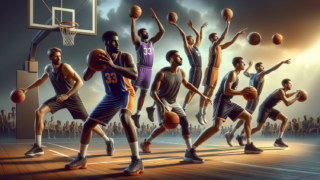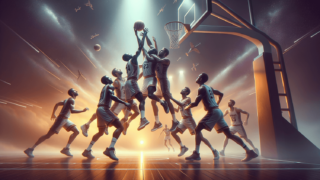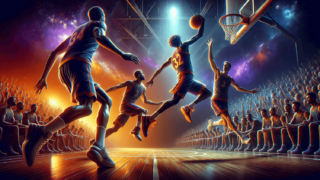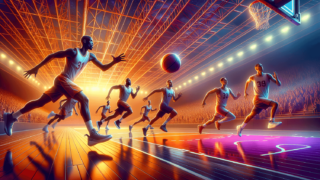
How to Master the Art of Rebounding in Basketball?
Written by: Basketball Universe
Last updated:

Are you ready to elevate your game by taking control of the boards? Welcome to our in-depth guide on how to master the art of rebounding in basketball! Dominating the rebounding game not only impresses your teammates and opponents, but also significantly increases your team’s chances of success on the court. From tips on position and box-outs to insights on anticipation and hustle, we’ve got the must-know secrets for aspiring glass-cleaners out there. So, prepare to rise above the crowd – both literally and figuratively – as we share our expertise on this crucial but often underrated aspect of basketball.
How to Master the Art of Rebounding in Basketball?
To master the art of rebounding in basketball, focus on improving your positioning, boxing out, anticipation, and hustle. Position yourself closer to the basket, maintain a wide stance, and utilize your body to box out opponents effectively. Develop your ability to predict the ball’s trajectory and practice quick reactions for better chances of securing the rebound. Enhance your physical fitness and maintain a never-give-up attitude to out-hustle opponents for those precious boards.
1. The Key Elements of a Master Rebounder
Before we dive into specific strategies, let’s get acquainted with the primary skills and qualities that help players become expert rebounders in the game of basketball:
A. Positioning
Great rebounders know where to be on the court. They recognize prime real estate near the basket, which puts them in the best possible position to secure rebounds. Being closer to the hoop allows players to quickly establish themselves as a physical presence, making it more difficult for opponents to beat them to the ball.
B. Boxing out
Boxing out is fundamental to effective rebounding. This technique involves using the body to put distance between an opponent and the basketball, giving players a better chance of grabbing rebounds off the glass. Mastering this skill is crucial for keeping the competition at bay and improving your rebounding prowess.
C. Anticipation
Predicting the trajectory of the ball and reacting accordingly is an essential component of rebounding. Players who develop their anticipation skills have a significant advantage when it comes to collecting missed shots, which can drastically boost their rebounding statistics.
D. Hustle
Simply put, rebounding is all about perseverance and hard work. Tenacious players who chase the basketball with relentless energy create more opportunities for themselves and their teammates, helping the team seize control of the game.
2. Establishing Superior Positioning
Now that we’ve covered the basics, let’s dive into each aspect of rebounding mastery:
A. Read the game
One of the keys to great positioning is a strong understanding of basketball tactics and situations. Players must read the game to determine when a shot will be taken, as well as anticipate where the ball will likely land if it misses the target. Identifying patterns and adjusting your position accordingly can lead to more successful rebounding opportunities.
B. Fight for inside position
To gain a positional advantage, make every effort to maintain the inside position between your opponent and the basket. This requires quick feet, strong body position, and determination. Being closer to the basket increases the likelihood of securing a rebound and can even lead to easier put-backs and scoring opportunities.
C. Stay between your man and the basket
No matter where you are on the floor, always maintain a position that places you between your assignment and the hoop. This forces the opponent to work harder to get into rebounding territory, giving you a leg up when vying for these critical possessions.
3. Boxing Out Like a Pro
Learning to box out effectively is crucial for anyone who wants to become a dominant rebounder. Let’s explore how to do it:
A. Maintain a wide stance
The wider your stance, the harder it is for an opponent to get around you. Adopting a solid base not only helps you secure boards but also prevents opponents from sneaking in and snatching rebounds from your grasp.
B. Keep your center of gravity low
Lowering your center of gravity gives you greater stability and leverage when boxing out. By staying low and balanced, you can effectively use your body to keep the competition at bay, allowing you to out-rebound taller or more athletic players.
C. Actively engage your arms
Arms play a crucial role in boxing out. Extending your arms outwards creates more space between you and your opponents, giving you an extra edge when it comes to battling for rebounds. By actively engaging your arms, you can also disrupt the rhythm and timing of the opposition as they attempt to jump and snatch the ball.
4. Hone Your Anticipation Skills
Improving your ability to predict and react to the ball’s trajectory is a critical component of successful rebounding:
A. Watch the ball and the shooter
When a shot is taken, pay attention to the ball’s flight path and how the shooter releases the basketball. Observations like these can help you better anticipate where the basketball might end up if the shot is off-target. Once you get the hang of reading these visual cues, you’ll find yourself in a better position to secure rebounds.
B. Study the backboard and rim
Both the backboard and rim influence the direction and speed of the basketball after a missed shot. Knowing which part of the rim the ball is likely to hit can provide insight into potential rebound locations. Practice watching the ball hit the rim, observing how it bounces and using that information to your advantage on the court.
C. Master the art of timing
Too often, players mistime their jump when going for a rebound. Developing a sense of when to leave the floor will improve your rebounding efficiency. Focus on sharpening your timing with dedicated practice, and soon you’ll be plucking rebounds out of the air with ease.
5. Embrace the Hustle
Finally, embrace the most intangible yet powerful aspect of rebounding – the hustle. Here’s how:
A. Maintain relentless energy
Playing with boundless enthusiasm can compensate for a lack of height or physicality when it comes to rebounding. Keep your energy levels high and relentlessly pursue the basketball, even in situations where the odds seem stacked against you.
B. Develop physical endurance
Being in great cardiovascular shape enables you to out-maneuver and out-push opponents when the game is on the line. Engage in regular aerobic and strength training exercises to increase your stamina, which will then translate into more effective rebounding efforts on the court.
C. Adopt a never-give-up attitude
An unwavering determination can make all the difference between securing a rebound and watching it slip through your fingers. Even when faced with taller or more athletic players, maintaining a never-give-up attitude will put you in a position to beat the competition and secure those game-changing boards.
By incorporating these fundamental practices and strategies into your basketball repertoire, you’ll soon find yourself on the path to mastering the art of rebounding. Remember, it’s not solely about height or athleticism; discipline, technique, and effort are equally important contributors to thriving in this crucial aspect of the game.
6. Learn from the Rebounding Legends
Studying the game of basketball’s all-time great rebounders provides valuable insights into what makes a dominant force on the boards. From Dennis Rodman’s relentless pursuit to Tim Duncan’s impeccable fundamentals, these players offer techniques and strategies that can be adapted and utilized by aspiring rebounders everywhere.
A. Dennis Rodman
In many ways, Dennis Rodman epitomized the hustler’s approach to rebounding. Despite being undersized for his position, Rodman’s tenacity, quickness, and sheer determination allowed him to become one of the NBA’s most dominant rebounders. Studying Rodman’s game highlights the importance of outworking opponents and never taking a possession off.
B. Tim Duncan
Known as “The Big Fundamental,” Tim Duncan built a Hall of Fame career on a foundation of sound mechanics and disciplined play. Duncan’s exceptional box-out ability, intelligent positioning, and keen understanding of the game offered a blueprint for budding rebounders to follow. Emulating Duncan’s attention to the fundamentals will set you apart from the competition.
C. Charles Barkley
Charles Barkley, despite standing only 6’6″ tall, was a dominant force on the boards throughout his career. Barkley’s strong, wide stance enabled him to maintain a low center of gravity, making it difficult for taller players to move him out of position. Utilizing Barkley’s approach to leverage and physicality can help you overcome height and athleticism disadvantages.
7. Practice Drills for Rebounding Success
Incorporating specific drills into your training routine will effectively develop the necessary skills and techniques required for rebounding mastery:
A. Tip Drill
This exercise emphasizes the development of timing, hand-eye coordination, and ball control. Players form a circle around the basket and take turns tapping the ball off the backboard without letting it hit the floor. Rotate around the basket and vary the tempo to hone your timing and touch around the rim.
B. Box-Out Drill
Pair up with a teammate or coach for this drill, designed to improve your boxing-out abilities. Have your partner attempt a shot in the paint while you work on maintaining a proper box-out stance. Focus on keeping a wide and low stance, staying between your partner and the basket, and engaging your arms to create separation.
C. Board Man Drill
In this drill, players stand on one side of the key and race to the other side to secure a rebound off a missed shot. The objective is to work on your positioning, quickness, and anticipation, all while competing against other teammates or players at the gym. The first player to collect a predetermined number of rebounds is the winner.
8. Strengthen Your Body for Better Rebounding
Improving physical strength and explosiveness can significantly enhance your rebounding performance. Implementing strength and plyometric exercises into your training regimen will translate into more powerful box-outs, higher jumps, and increased rebounding proficiency:
A. Squats and Deadlifts
Both squats and deadlifts are compound exercises that target major muscle groups in the lower body, enhancing overall strength and stability. These movements will help you maintain a strong base and lower center of gravity, making it difficult for opponents to dislodge you from your box-out stance.
B. Box Jumps and Vertical Leap Exercises
Explosive movements like box jumps and vertical leap exercises increase lower-body power, enabling you to jump higher and out-reach opponents. Incorporating these exercises into your training will improve your leaping ability and overall athleticism, providing an edge when competing for lofty rebounds.
C. Core and Upper-Body Strength Training
Core strength is vital for maintaining stability and balance during box-outs and rebounding battles, while a robust upper body helps you fend off opponents and secure loose balls. Including exercises such as planks, push-ups, and pull-ups in your workout program will help you develop the strength needed to excel in rebounding battles.
Combining these various aspects of rebounding expertise – from the fundamentals to physical preparation – will set you on the path to rebounding mastery. Remember, an exceptional rebounder possesses a unique blend of technique, instincts, athleticism, and unyielding effort, all important qualities for players seeking to dominate the boards and elevate their basketball game.
FAQ: Mastering Rebounding in Basketball
To further assist you in your quest to become a proficient rebounder, we have compiled a list of frequently asked questions and answers that address common concerns, misconceptions, and tips. Use these insights to fine-tune your approach and dominate the boards.
1. Do I need to be a tall player to be a good rebounder?
No, many shorter players excel at rebounding due to their technique, positioning, and relentless effort. While being tall may offer an advantage in certain situations, hard work, determination, and intelligence can lead to rebounding success for players of all heights.
2. How can I increase my vertical jump for rebounding?
Improving your vertical jump involves targeted strength and plyometric training. Exercises like squats, deadlifts, box jumps, and vertical leap drills can help build lower-body explosiveness, enabling you to jump higher and secure more rebounds.
3. What is the role of my arms and hands when boxing out?
Your arms play a critical role in boxing out, as they help create space between you and your opponent. Extend your arms outwards to keep opponents from moving closer to the basket, which ultimately provides you with a better chance of securing the rebound.
4. How important is speed when it comes to rebounding?
Speed is a valuable asset for rebounders, as it enables quick positioning and allows for easier navigation around the court. A fast player can gain an advantageous position before an opponent, increasing the likelihood of capturing a rebound.
5. How can I practice rebounding on my own?
There are several lone-player exercises that can help you work on rebounding skills, such as tip drills, vertical leap exercises, and shooting your own missed shots. These drills not only improve rebounding abilities but also develop your sense of timing and anticipation.
6. Should I focus on offensive or defensive rebounding?
Both offensive and defensive rebounding are important elements of the game. While offensive rebounds can create second-chance scoring opportunities, defensive rebounds help prevent opponents from scoring. Balancing your efforts in both areas will benefit both you and your team.
7. How can I improve my reaction time for better rebounding?
Improving reaction time comes with practice and experience. Participate in game-like situations with varying levels of competition, adaptability, and improv drills, to develop quicker reflexes and instincts when it comes to securing rebounds.
8. How does my footwork impact my rebounding ability?
Proper footwork is essential for effective positioning and boxing out. Maintaining a wide, low stance and pivoting swiftly can help you achieve a stronger position for rebounding, making it harder for opponents to maneuver around you.
9. Can nutrition and sleep affect my rebounding performance?
Nutrition and sleep are vital factors in overall athletic performance, including rebounding. A well-balanced diet and adequate rest can optimize your energy levels, focus, and physical health, translating into improved performance in all aspects of the game, including rebounding.
10. Can mental toughness help improve my rebounding ability?
Yes, mental toughness plays a significant role in rebounding success. Maintaining a never-give-up attitude, even when faced with taller or more skilled opponents, can give you an edge when competing for rebounds. Mental resilience, combined with technique and determination, can take your rebounding game to new heights.
Featured Posts
- No pillar pages found.





